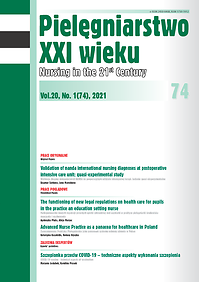Advanced Nursing Practice as a panacea for healthcare in Poland
DOI:
https://doi.org/10.2478/pielxxiw-2021-0002Keywords:
advanced nursing practice, advanced practice nurse, nursingAbstract
ADVANCED NURSING PRACTICE AS A PANACEA FOR HEALTHCARE IN POLAND
Introduction. Advanced Nursing Practice (ANP) is a relatively new concept in Poland. In order to be introduced, it needs a legal basis. There are specific regulations in Europe, yet they are only a framework for more detailed legislation in every member state of the European Union.
Aim. To discuss Advanced Nursing Practice principles and the benefits for the national healthcare system resulting from implementing ANP in Poland.
Discussion. Advanced Nursing Practice was defined in the 1950s in the United States of America. Presently in Europe and in Poland a definition by the International Council of Nurses (ICN) is applied. ICN has also defined the scope of competences for nurses of Advanced Practice. In Poland there already exist some regulations which substantially cover this scope. ANP implementation can naturally start in hospital settings. In ambulatory field ANP gives hope for effective transformation, namely increasing the efficiency and effectiveness of Primary Healthcare (pol. POZ) centers (comparable to General Practice in other countries).
Conclusions. Effective implementation of ANP in Poland requires a slight modification of existing legal acts, a properly developed educational system and proven solutions or concepts derived from other European countries' experience.
References
1. Directive 2013/55/EU of the European Parliament and of the Council of 20 November 2013 amending Directive 2005/36/EC on the recognition of professional qualifications and Regulation (EU) No 1024/2012 on administrative cooperation through the Internal Market Information System. Official Journal of the European Union L 354/132 of 28th December 2013.
2. Parliament of Republic of Poland, 2011. Act of 15 July 2011 on profession of nurse and midwife. In: Journal of Laws of 2011. No 174, item 1039. Retrieved April 15, 2020 from http://dziennikustaw.gov.pl.
3. State Minister of Health of Republic of Poland. Rozporządzenie Ministra Zdrowia z dnia 28 lutego 2017 r. w sprawie rodzaju i zakresu świadczeń zapobiegawczych, diagnostycznych, leczniczych i rehabilitacyjnych udzielanych przez pielęgniarkę albo położną samodzielnie bez zlecenia lekarskiego. In: Journal of Laws of 2017. No. 497. Retrieved April 15, 2020 from http://dziennikustaw.gov.pl
4. State Minister of Health of Republic of Poland. Rozporządzenie Ministra Zdrowia z dnia 18 stycznia 2018 w sprawie wykazu substancji czynnych zawartych w lekach, środków spożywczych specjalnego przeznaczenia żywieniowego i wyrobów medycznych ordynowanych przez pielęgniarki i położne oraz wykazu badań diagnostycznych, na które mają prawo wystawiać skierowania pielęgniarki i położne. In: Journal of Laws of 2018. No 299. Retrieved April 15, 2020 from http://dziennikustaw.gov.pl.
5. Main Statistical Office of Poland. Sytuacja demograficzna osób starszych i konsekwencje starzenia się ludności Polski w świetle prognozy na lata 2014-2050; Warszawa 2014:34. https://stat.gov.pl/download/gfx/portalinformacyjny/pl/ defaultaktualnosci/5468/18/1/1/ludnosc_w_starszym_wieku.pdf. Accessed on 25th April 2020.
6. OECD. Nurses. In: Health at a Glance 2019: OECD Indicators. OECD Publishing, Paris 2019. doi: 10.1787/98e2d5de-en. Accessed on 25th April 2020.
7. OECD. Doctors (overall number). In: Health at a Glance 2019: OECD Indicators. OECD Publishing, Paris 2019. doi: 10.1787/b33ab4c1-en. Accessed on 25th April 2020.
8. International Council of Nurses. ICN Nursing Care Continuum and Competences. Report 2008, Geneva.
9. Oxford English Dictionary. Oxford Univeristy Press, Oxford 2018. en.oxforddictionaries.com/definition/nurse_practitioner. Accessed on 25th April, 2020.
10. State Minister of Science and Higher Education of Republic of Poland. Rozporządzenie Ministra Nauki i Szkolnictwa Wyższego z dnia 26 lipca 2019 r. w sprawie standardów kształcenia przygotowującego do wykonywania zawodu lekarza, lekarza dentysty, farmaceuty, pielęgniarki, położnej, diagnosty laboratoryjnego, fizjoterapeuty i ratownika medycznego. In: Journal of Laws of 2019. No. 1573.
11. State Council of Ministers of Republic of Poland. Uchwała Rady Ministrów nr 124/2019 z dnia 15 października 2019 r. w sprawie przyjęcia dokumentu „Polityka Wieloletnia Państwa na Rzecz Pielęgniarstwa i Położnictwa w Polsce (z uwzględnieniem etapów prac zainicjowanych w roku 2018)”. https://www.gov.pl/web/zdrowie/polityka-wieloletnia-panstwa-na-rzecz-pielegniarstwa-i-poloznictwa-w-polsce. Accessed on 25th April 2020.
12. Nursing&Midwifery Council. Becoming a nursing associate. https://www.nmc. org.uk/education/becoming-a-nurse-midwife-nursing-associate/becoming-a-nursing-associate. Accessed on 21st May 2020.
13. Royal College of Nursing. RCN Credentialing for Advanced Level Nursing Practice (Handbook for applicants). Royal College of Nursing, London 2017.
14. Schäfer D. Die Zukunft der „Advanced Practice Nurse” in Österreich (A. Schönthaler interview). Pflege Professionell, 2018; 15. https://pflege-professionell.at/die-zukunft-der-advanced-practice-nurse-in-oesterreich. Accessed on 25th April 2020.
Downloads
Published
Issue
Section
License
Copyright (c) 2021 Authors

This work is licensed under a Creative Commons Attribution-NonCommercial-NoDerivatives 4.0 International License.




